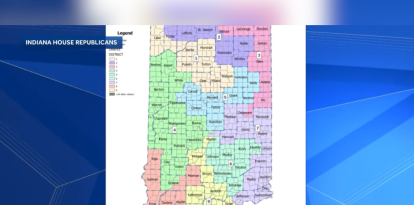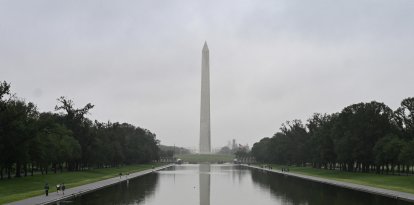Hispanics in the USA, the "sleeping giant"
The Hispanic community is increasingly decisive in the country. The largest minority in the United States celebrates its 4th of July in full growth.

(Shari Sirotnak-Unsplash)
Is it possible to speak of a minority of 60 million people? This is the case of Hispanics in the United States of America. A human force that is a fundamental part of the nation and a key player in its prosperity. Hispanic population has been settled in the United States for more than five centuries. And, of course, this 4th of July, Independence Day, is part of their own culture.
Of the more than 331 million inhabitants of the United States, 62 million are of Hispanic origin. Mexico is the country that contributes more Hispanic-Americans to the nation (more than 36 million, 62%), well ahead of Puerto Rico and Cuba (5.7 and 2.4 million, respectively).
By the year 2060, the United States will be the second largest Spanish-speaking country in the world, behind only Mexico. Some 27.5% of the country's population will be of Hispanic origin (111 million ). Currently, 1 in 6 of the population is Hispanic. According to The Hispanic Council, Hispanic population has grown since 2018 by a million people a year.
The United States is the country with more Spanish speakers, where Spanish is not the official language. 42.5 million people in the country are native speakers and 15 million have limited proficiency. Spanish is the second most studied language at all school levels in the country. Twelve percent of the population speaks Spanish at home; that is, more than 40 million people.
Hispanic strength in the USA
Hispanics represent 18.4% of the U.S. population and 17.3% of the labor force, a proportion that will increase to more than 30% by 2060. According to 2020 census data,
The three states with higher percentage of Hispanic population are New Mexico (47.7%), California (39.4%) and Texas (39.3%).
In contrast, the three states in which the Hispanic Hispanic population grew the most between 2010 and 2020 were North Dakota (148.1%), South Dakota (75.1%) and Vermont (68.4%). As The Hispanic Council highlights, growth of the Hispanic population is a widespread phenomenon throughout the country: There is not a single State in which Hispanic population has decreased in the last decade.
In the year 2000, only ten states had registered more than 10% of Hispanic population. At 2020 were already 23 percent. The latest update brings the figure to 27 more than half of the total.
States with over 10 percent Hispanic population (The Hispanic Council, THC)
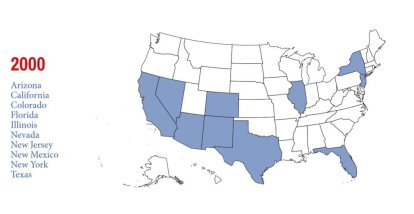
States with more than 10% Hispanic population in 2000. Source: U.S. Census Bureau-The Hispanic Council

States with more than 10% Hispanic population in 2010. Source: U.S. Census Bureau-The Hispanic Council
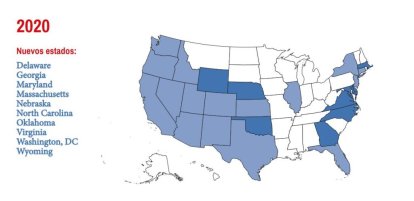
States with more than 10% Hispanic population in 2020. Source: U.S. Census Bureau-The Hispanic Council
The strength of the Hispanic community is evident and its representation is growing throughout the country. Hispanic is part of the United States and will be increasingly present in all areas.
The power of the Hispanic vote
In 2008, the Hispanic vote comprised 9% of the electorate, and in 2016, 11%. In the year 2000, less than 20 million of Hispanic was eligible to vote according to the census, whileafter the year 2016 this figure exceeded 27 million. A growth of 70% in less than two decades.
In the midterms of the year 2018 were 29.1 million Hispanics eligible to vote. At the last presidential elections (2020), the figure stood at over 32 million. The Hispanic Council 's analysis reflects that the Hispanic community recorded record participation numbers.
After decades of low turnout, the Hispanic vote has become known as "the sleeping giant". In 2020, the Hispanic community was for the first time the largest minority group in the world.the most weight in the election. They represented the 13.3% of the electorate, confirming that the Hispanic vote is increasingly crucial in increasingly crucial in some key states in the country.
States with the highest number of Hispanic voters (THC)
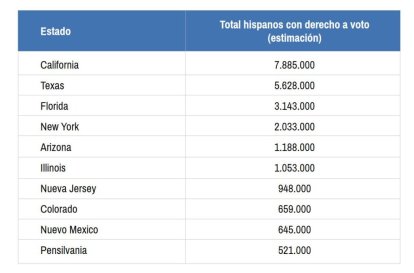
Estimated number of Hispanics eligible to vote by state. Source: Pew Research Center
These are the general data. In percentage terms, and as we have previously pointed out, Hispanics represent no less than 43% of the vote in New Mexico, and in Texas and California they are well over 30%.
Hispanics have grown in both numbers and political participation in recent decades. Their trajectory is fundamental cultural, social and economic trajectory of the country. And every day they add up to more in every field. The future is Hispanic and American. Enjoy your 4th of July.














